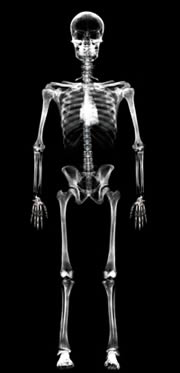- 2/12/2004
- HELEN R. PILCHER

A British study has quantified the cancer risk from diagnostic X-rays. Radiation from medical and dental scans is thought to cause about 700 cases of cancer per year in Britain and more than 5,600 cases in the United States1.
The benefits of using X-rays still far outweigh the potential increase in cancer risk, says Amy Berrington de González from Oxford University, UK, who coordinated the study. But it’s important to know what that risk is, she says, so doctors can weigh up the pros and cons of using the technique.
X-rays and their computerized cousin, CT scans, are routinely used to diagnose cancer and examine bone breaks. But the radiation can penetrate through cells and damage DNA. In some people, this can trigger cancer.
To minimize the risks, doctors use low doses. A chest X-ray, for example, delivers just three days’ worth of low, background radiation. But X-rays are commonplace in hospitals and huge numbers of people receive them — there are 500 X-rays for every 1,000 people every year in Britain.
Attempts to quantify the risk of X-rays have been made before. The most recent previous estimate, made in 1981, found that X-rays probably accounted for 0.5% of cancer cases in the United States.
The new study, using more data from 15 different countries, is a much-needed update on those risk estimates, says Berrington de González, particularly because many more X-rays are done today than 20 years ago. The study estimates that diagnostic X-rays account for 0.9% of cancer cases in the United States, although the authors caution that their methodology is very different from that used previously, making it hard to compare the results.
Working backwards
To make their calculations, Berrington de González and colleague Sarah Darby assessed the relationship between high levels of radiation exposure and cancer. This included information on survivors of the Hiroshima bomb, who were exposed to radiation levels far greater than the normal X-ray exposure. The duo then worked backwards to work out the risks from lower doses.
Scaling down from large exposures to small ones is a difficult and controversial calculation, however. So the pair also used a complex computer model to try and weed out the effects of lower doses of radiation.
They found that about 0.6% of cancer cases in Britain are currently caused by X-rays. Poland, Sweden, Kuwait and the Netherlands have similar rates. The highest rate — 3% — was found in Japan, where X-ray use is more common.
X-rays are not the only diagnostic tool available to doctors, says Paul Dubbins, dean of the UK-based Royal College of Radiologists. Ultrasound can be used to image a baby in the womb, for example. But ultrasound doesn’t travel well through air, so is rarely used for lung examinations. Magnetic resonance imaging (MRI) can be used to study brain activity, but is not very good at imaging bones. “We don’t use X-rays unless they’re absolutely necessary,” says Dubbins.
It’s not possible to predict who will develop cancer as a result of X-ray exposure, or what type of cancer they will get, says Berrington de González. Radiation can trigger many different types of the disease. On the other hand, not all cancers are caused by radiation — diet and genetics, for example, also play a role.

Leave A Comment
You must be logged in to post a comment.